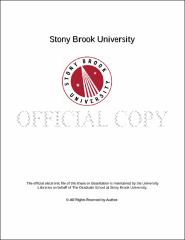| dc.identifier.uri | http://hdl.handle.net/11401/76579 | |
| dc.description.sponsorship | This work is sponsored by the Stony Brook University Graduate School in compliance with the requirements for completion of degree. | en_US |
| dc.format | Monograph | |
| dc.format.medium | Electronic Resource | en_US |
| dc.language.iso | en_US | |
| dc.publisher | The Graduate School, Stony Brook University: Stony Brook, NY. | |
| dc.type | Dissertation | |
| dcterms.abstract | This thesis examines the expression and function of alternately spliced isoforms of No Mechanoreceptor Potential C (NOMPC), a TRPN ion channel protein expressed in several types of mechanosensory neuron in Drosophila. nompC mutant flies are severely uncoordinated; electrophysiological recordings show that they lack receptor currents in mechanosensory bristles and have reduced sound-evoked potentials in the antennal nerve. Exons 14 and 15 of the nompC gene both encode a highly conserved part of the protein, including the channel pore. To find how these exons are used, I first identified six different cDNA isoforms. Among these were two major isoforms with mutually exclusive splice patterns including either exons 13 and 14, or exon 15. Conservation of the alternate exons in several holometabolan insect orders suggests that both are functional. This was confirmed by rescuing nompC mutants by expressing single isoforms from cDNA transgenes. Both beta and gamma isoforms rescue the nompC mutant phenotypes, but they show different mechanoreceptor current properties: the gamma isoform has a larger adapting current amplitude, and a smaller adaptation time constant. Quantitative RT-PCR showed that the gamma isoform is the more abundant form in all tissues and developmental stages, and that the beta isoform is most enriched in the haltere. To detect isoform expression patterns with cellular resolution, I designed two splice-reporter genes UAS-FSR-beta and UAS-FSR-gamma; each produces a visible product only when the corresponding pore exon is included in the mRNA. Mechanosensilla on the wing blade showed a perfect correlation between isoform production and previously described physiology: FSR-beta is produced in slowly adapting (tonic) neurons and FSR-gamma in fast adapting neurons. In haltere and wing hinge sensilla, the reporters revealed overlapping but differentiated expression patterns. Bristles on the notum or legs produced only FSR-gamma. In the antennal chordotonal organ, FSR-gamma was produced in all neurons, but FSR-beta was detected only in a subset of neurons thought to respond to low-frequency stimuli. Other chordotonal organs also showed differential isoform expression. I conclude that through alternate splicing, different nompC isoforms are produced in different sensory neurons and that they are specialized for sensing diverse mechanical stimuli. | |
| dcterms.available | 2017-09-20T16:50:42Z | |
| dcterms.contributor | Kernan, Maurice J | en_US |
| dcterms.contributor | Turner, Glenn | en_US |
| dcterms.contributor | Matthews, Gary | en_US |
| dcterms.contributor | Eberl, Daniel. | en_US |
| dcterms.creator | Huang, Shao-Kuei | |
| dcterms.dateAccepted | 2017-09-20T16:50:42Z | |
| dcterms.dateSubmitted | 2017-09-20T16:50:42Z | |
| dcterms.description | Department of Neuroscience. | en_US |
| dcterms.extent | 101 pg. | en_US |
| dcterms.format | Application/PDF | en_US |
| dcterms.format | Monograph | |
| dcterms.identifier | http://hdl.handle.net/11401/76579 | |
| dcterms.issued | 2014-12-01 | |
| dcterms.language | en_US | |
| dcterms.provenance | Made available in DSpace on 2017-09-20T16:50:42Z (GMT). No. of bitstreams: 1
Huang_grad.sunysb_0771E_12156.pdf: 6257151 bytes, checksum: 6cd1217022d414a963bebd9c9f189164 (MD5)
Previous issue date: 1 | en |
| dcterms.publisher | The Graduate School, Stony Brook University: Stony Brook, NY. | |
| dcterms.subject | adaptation, alternate splicing, mechanosensory, nompC | |
| dcterms.subject | Neurosciences | |
| dcterms.title | Alternate pore isoforms of a mechanosensory ion channel in Drosophila | |
| dcterms.type | Dissertation | |

